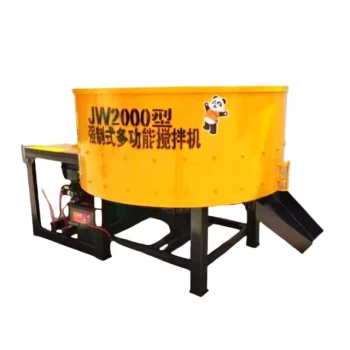The primary disadvantages of a volumetric concrete mixer are its heavy reliance on operator skill for a quality product, the potential for an inconsistent mix if raw materials are wet, and the generation of excessive dust. Unlike plant-batched concrete, the quality control process shifts entirely to the job site, introducing significant variables that can impact the final strength and consistency of the concrete.
The core trade-off of a volumetric mixer is accepting greater on-site responsibility for quality control in exchange for maximum flexibility. Its effectiveness is directly tied to the experience of the operator and the condition of the raw materials at the moment of mixing.

The On-Site Quality Control Challenge
The greatest strength of a volumetric mixer—mixing fresh concrete on-site—is also the source of its most significant drawbacks. Quality assurance is no longer centralized at a controlled plant.
Operator Skill is Paramount
A volumetric mixer is only as good as the person running it. The operator is responsible for calibration, monitoring material flow, and making real-time adjustments.
An inexperienced operator can easily produce an inconsistent mix, directly compromising the structural integrity of the final product.
The Problem of Wet Aggregates
The system measures materials by volume, not weight. If sand and stone are wet, they take up more volume and contain unaccounted-for water.
This moisture throws off the critical water-to-cement ratio, a primary driver of concrete strength. The result can be a mix that is weaker than specified, even if the machine is calibrated correctly.
Risk of Excess Bleed Water
An inconsistent or overly wet mix often leads to excess bleed water. This is where water rises to the surface of freshly poured concrete.
Excessive bleeding can weaken the top surface, increase porosity, and delay finishing times, ultimately affecting the durability of the slab.
Operational and Environmental Hurdles
Beyond mix quality, the physical nature of operating a volumetric mixer presents practical challenges on a job site.
Significant Dust Generation
The process of conveying and mixing dry materials like cement and sand on an open site can produce a significant amount of airborne dust.
This poses health risks and can be a major issue on sites with strict environmental regulations or in dense urban areas.
Large Footprint and Weight
These are large, heavy trucks. A fully loaded unit can weigh up to 42 tonnes, requiring roads and site access points capable of supporting that load.
They also need a considerable amount of level, stable ground to operate safely, which can be a limitation on constrained or undeveloped job sites.
Operational Complexity
Volumetric mixers are complex machines that require diligent maintenance and frequent calibration to ensure accuracy.
Failure to properly clean and maintain the augers, gates, and conveyor systems can lead to inaccurate batching and costly breakdowns.
Making the Right Choice for Your Project
Choosing between a volumetric mixer and a traditional barrel truck depends entirely on the project's specific demands for flexibility versus certified consistency.
- If your primary focus is flexibility: A volumetric mixer is ideal for projects requiring multiple small pours, different mix designs on the same day, or work in remote locations far from a batch plant.
- If your primary focus is certified consistency: A traditional ready-mix truck is superior for large, single-specification pours where the quality control of a centralized batch plant is critical.
- If your worksite has strict environmental or space constraints: The potential for dust and the large operational footprint of a volumetric mixer may make it unsuitable.
Ultimately, understanding these limitations is the key to leveraging the unique advantages of on-site mixing.
Summary Table:
| Disadvantage | Key Impact |
|---|---|
| Reliance on Operator Skill | Quality and consistency are directly tied to the operator's experience. |
| Inconsistent Mix from Wet Materials | Wet aggregates can disrupt the water-to-cement ratio, weakening the concrete. |
| Significant Dust Generation | Poses health risks and can be problematic in environmentally sensitive areas. |
| Large Footprint & Weight | Requires robust site access and ample, stable operating space. |
Need a More Reliable Concrete Solution?
While volumetric mixers offer flexibility, their quality depends heavily on on-site conditions. For projects where certified consistency and strength are non-negotiable, consider the reliability of plant-batched concrete.
GARLWAY specializes in construction machinery, offering robust concrete batching plants and mixers designed for durability and precise performance. Our solutions help construction companies and contractors globally achieve superior results with guaranteed quality control.
Ensure your project's success with equipment you can trust. Contact our experts today to find the perfect concrete solution for your needs!
Visual Guide

Related Products
- Construction Products Concrete Plant Machine Mixing Concrete Mixer
- HZS90 Large Multiquip Concrete Mixers for Construction
- JDC350 Small Cement Concrete Mortar Mixer
- JS1000 Volumetric Concrete Mortar Mixer for Sale Skid Steer Cement Mixer
- JZC500 Large Cement Mixer Machine Price for Concrete Mix
People Also Ask
- How does concrete not harden in a truck? The Role of Continuous Agitation Explained
- How much does a batching plant cost? Uncover the True Investment for Your Project
- How to choose the right concrete mix? A Guide to Balancing Strength, Workability, and Cost
- What are the factors influencing choice of a concrete mixing plant? Key Considerations for Efficiency
- Can a concrete mixer be used for mortar? Understanding the trade-offs for your project














